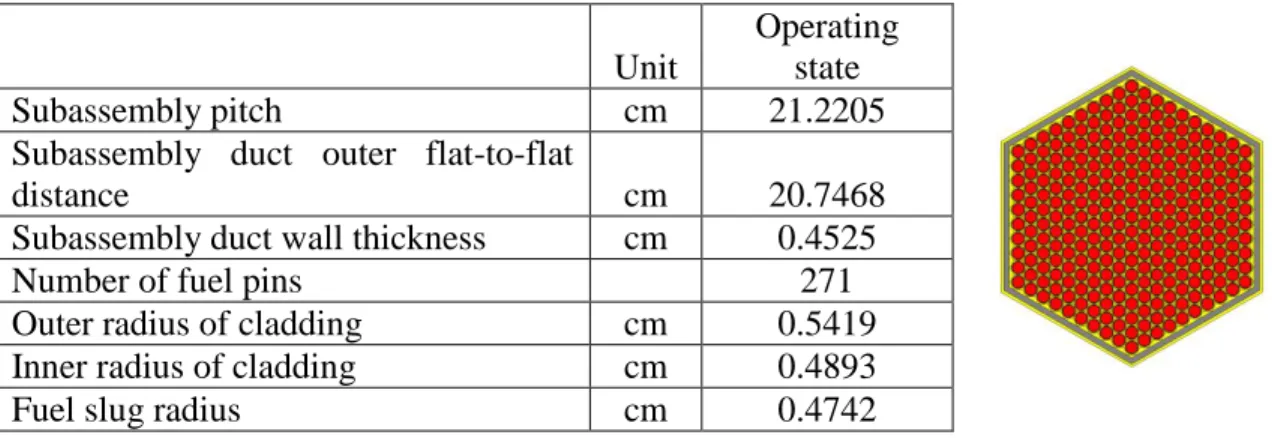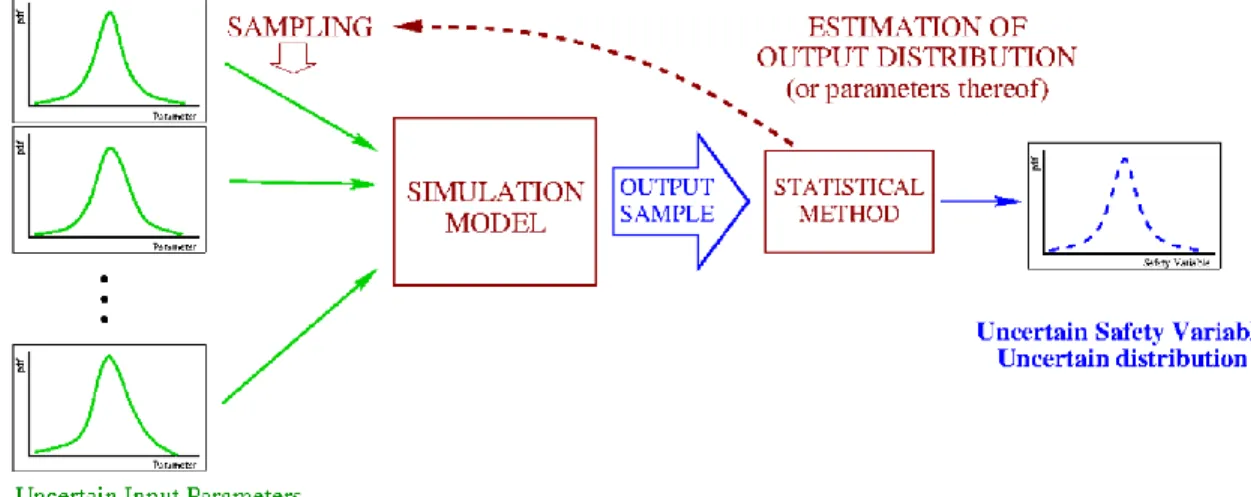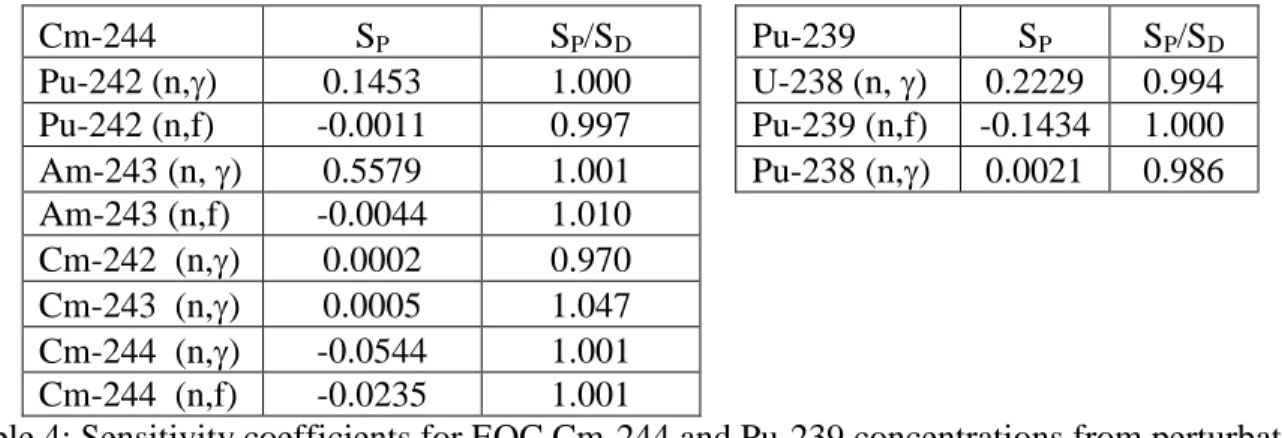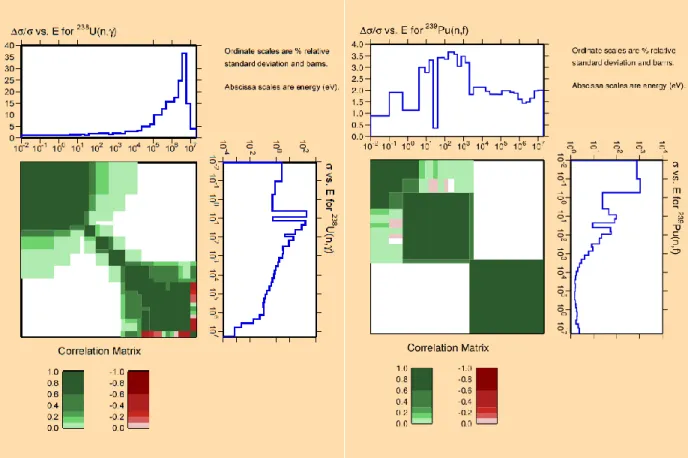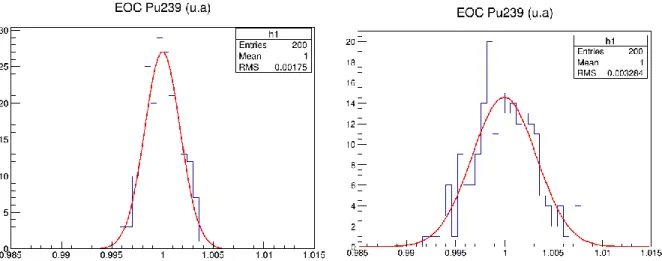HAL Id: cea-02400194
https://hal-cea.archives-ouvertes.fr/cea-02400194
Submitted on 9 Dec 2019
HAL is a multi-disciplinary open access
archive for the deposit and dissemination of sci-entific research documents, whether they are pub-lished or not. The documents may come from teaching and research institutions in France or abroad, or from public or private research centers.
L’archive ouverte pluridisciplinaire HAL, est destinée au dépôt et à la diffusion de documents scientifiques de niveau recherche, publiés ou non, émanant des établissements d’enseignement et de recherche français ou étrangers, des laboratoires publics ou privés.
sensitivity/uncertainty propagation with depletion
L. Buiron, G. Rimpault
To cite this version:
L. Buiron, G. Rimpault. NEA SFR subassembly benchmark sensitivity/uncertainty propagation with depletion. BEPU 2018 (ANS Best Estimate Plus Uncertainty International Conference), May 2019, Lucca, Italy. �cea-02400194�
NEA SFR SUBASSEMBLY BENCHMARK: SENSITIVITY/UNCERTAINTY PROPAGATION WITH DEPLETION
L. Buiron1, G. Rimpault1
1
CEA, DEN, DER, Cadarache, 13108 Saint-Paul-Lez-Durance Cedex France laurent.buiron@cea.fr, gerald.rimpault@cea.fr
ABSTRACT
For the next generation of fast reactors, global objectives are required in terms of safety improvement, sustainability, waste minimization and non-proliferation. Concerning safety issues, particular efforts have been made in order to obtain core designs that can be resilient to accidental transients. Under the auspices of the Working Party on Scientific Issues of Reactor Systems (WPRS) an OECD/Nuclear Energy Agency (NEA) Expert Group Task Force on Uncertainty Analysis in Best-Estimate Modelling (UAM) for Design, Operation and Safety Analysis of Sodium-cooled Fast Reactors (SFR-UAM) has been initiated in 2015 with the objective to study the uncertainties in different stages of the next generation Sodium Fast Reactors. Among the identified topics of this expert group, a representative SFR fuel subassembly depletion benchmark has been set up in order to analyse the reactivity swing as well as the associated uncertainty level based on available nuclear data variance/covariance matrices coming from evaluations. The benchmark focuses on changes on number densities, on Doppler Effect and sodium void worth as well as kinetic parameters from the beginning of equilibrium cycle up to the end of cycle. For sensitivity/uncertainty estimation, two methods are tested: a deterministic one based on sensitivities and a stochastic one using direct nuclear data sampling. In the deterministic approach, Boltzmann and Bateman equations are coupled at the sensitivity level with the help of the perturbation theory. This coupling is currently operational in ERANOS code system. The present implementation gives sensitivities for both reactivity coefficients and mass balance. For stochastic approach, relevant nuclear data set are directly sampled from variance/covariance data and used as input parameter for neutronic calculations. Both methods are found to be consistent.
1. INTRODUCTION
For the next generation fast reactor design, many efforts have been made in the last years to obtain industrial core designs that can be resilient to accidental transients. The “safety” level of such new designs is often characterized by their “natural” behaviour under protected or unprotected transients such as loss of flow or hypothetical transient over power. Transient analysis needs several input data such as reactivity coefficient and kinetic parameters. These inputs are the result of neutronic calculations involving deterministic codes based on several approximations (either related to geometrical description or numerical methods) that need to be
mastered. Thus the confidence level of the safety demonstration relies on best-estimate methods as well as exhaustive knowledge of the associated uncertainties.
Within the activities of the Working Party on Scientific Issues of Reactor Systems (WPRS) of the OECD/NEA, an international collaboration was conducted in 2009 (SFR-Task Force expert group) to assess the core performance characteristics and reactivity feedback coefficients of several Sodium-cooled Fast Reactor (SFR) concepts with various fuel forms such as oxide, carbide and metal alloy. Four numerical benchmark cases were initially developed with large and medium core sizes in order to perform:
Neutronic characterization of global parameters (k-effective, power and flux distributions, sodium void effect, Doppler, etc.) for beginning of equilibrium cycle as well end of equilibrium cycle by means of core depletion operating at full power,
Feedback coefficients evaluation, based on a common calculation methodology.
Transient calculations, with the use of previous feedback coefficient, on few selected cases for the principal unprotected transients (unprotected transient overpower (UTOP), unprotected loss of flow (ULOF), unprotected loss of heat sink (ULOHS) and the core behaviours characterized using a matrix classification.
The aim was to share the analysis among different institute involved in Fast Reactor design and to make recommendation on calculation hypothesis requirement in terms of accuracy as well as to converge on a common methodology to perform best estimate evaluation of such system. Eleven organizations contributed to this benchmark: ANL, CEA of Cadarache, CEA of Saclay, CER, ENEA, HZDR, IKE, JAEA, KIT, SCK-CEN, and University of Illinois. The contributors applied different calculation methodologies (calculation codes, cross-section libraries, approximations, etc…) and the results were exhaustively analysed by the expert group formed hereby.
Beyond the use of different cross section libraries, most of the observed discrepancies were found out to come from the various approximations made in the treatment of deterministic codes, mainly at the lattice level: geometrical modelling of the lattice (heterogeneous vs homogeneous model), energy mesh considered, etc. Due to the large amount of input data and the associated results, the expert group was not able to perform the exercise up to transient calculation.
Under the auspices of the WPRS a new Expert Group Task Force on Uncertainty Analysis in Best-Estimate Modelling (UAM) for Design, Operation and Safety Analysis of Sodium-cooled Fast Reactors (SFR-UAM) has been initiated in 2015 with the objective to study the uncertainties in different stages of the next generation Sodium Fast Reactors. Among the identified topics of this expert group, a representative SFR fuel subassembly depletion benchmark has been studied in order to analyse various contributions to the reactivity swing as well as the associated uncertainty level based on available nuclear data variance/covariance matrices coming from evaluations. This particular topic is a unique opportunity to study in depth the impact of depletion on the main parameters of interest for core design purpose.
Beside estimation of the level of “absolute” values, associated uncertainties have also to be evaluated for the whole set of relevant data. This means that uncertainties have to be obtained not only a fixed time but also have to be propagated all through irradiation. After a brief description of the benchmark content, results using the ERANOS code package are presented regarding best-estimated results. Partial sensitivity/uncertainty characterization based on
Bateman/Boltzmann coupling is also investigated for both quasi-static deterministic and a “probabilistic” approach.
2. BENCHMARK RESULTS 2.1 Benchmark description
As pointed out by the SFR-Task Force expert group in the first SFR benchmark exercise, the large discrepancies observed in nuclides number densities as well as feedback coefficients at the end of one cycle core irradiation were identified to come from the very different input data related to depletion chain and inherent isotopic energy release used in the depletion process. In order to perform in depth analysis of the influence of these parameters a new benchmark focusing on a single sub-assembly depletion has been proposed in the frame of the SFR-UAM as a step toward an exhaustive study on such topic.
The lattice input data comes from one of the ten representative subassemblies of the SFR MOX-3600MW oxide core [1] at beginning of equilibrium cycle (see Table 1 for lattice geometrical data, and reference [1] for material description).
Unit
Operating state
Subassembly pitch cm 21.2205
Subassembly duct outer flat-to-flat
distance cm 20.7468
Subassembly duct wall thickness cm 0.4525
Number of fuel pins 271
Outer radius of cladding cm 0.5419 Inner radius of cladding cm 0.4893
Fuel slug radius cm 0.4742
Table 1: Sub-assembly geometrical data
The benchmark focuses on change on number densities, reactivity effect such as Doppler Effect and sodium void worth as well as kinetic parameter from the beginning of equilibrium cycle up to the end of cycle (410 Equivalent Full Power Days) within at least four steps. For each step the expected results are the following:
multiplication factor, neutron flux level nuclide densities of fuel:
o Actinides: U-233, U-234, U-235, U-236, U-238, Np-237, Np-239, 238, Pu-239, Pu-240, Pu-241, Pu-242, Am-241, Am-242, Am-242m, Am-243, Cm-242, Cm-243, Cm-244, Cm-245, Cm-246
o Fission products: Kr-85, Mo-42, Sr-90, Mo-95, Tc-99, Ru-101, Ru-106, Rh-103, Ag-109, Te-132, I-129, Xe-131, Xe-135, Cs-133, Cs-134, Cs-135, Cs-137, La-139, Ce-140, Ce-142, Ce-144, 142, 143, 144, 145, 146,
Nd-148, Nd-150, Sm-147, Sm-Nd-148, Sm-149, Sm-150, Sm-151, Sm-152, Sm-154, Eu-151, Eu-153, Eu-154, Eu-155, Gd-154, Gd-155, Gd-156, Gd-158, Gd-160
Feedback reactivity coefficients: sodium void reactivity by changing the Na-23 density from the nominal value to 1%, Doppler reactivity by changing the fuel temperature from nominal value to 750 K.
In order to perform uncertainty calculation afterward, other input data or results (depending on the used tools or approach) are also required such as branching ratios for capture reactions, energy release values for fission and capture reactions and fission yield values.
2.2 Results based on ERANOS code package
The ERANOS code package [2] has been widely used for fast reactor studies for decades. It has been developed in the frame of the SuperPhenix project and incorporates suitable models for traditional hexagonal wrapped pin fuel bundle at lattice level. The ECCO module can perform lattice calculation on exact hexagonal geometry using the following hypothesis:
Fundamental mode or macro-cell approximation (cluster),
Selfshielding using collision probability solver (Pij) solver and probability table, B1 leakeage model if required,
Fine mesh and energy group (1968 & 33 groups) for cross section generation, Flux-volume homogeneous collapsing capability.
In addition, based on the processed cross-sections provided by ECCO, ERANOS allows to perform core transport calculation using discrete ordinates Sn calculation on hexagonal and cartesian 2D geometries or nodal variational method in 3D hexagonal geometries. It also provides perturbation tools that give access to Standard Perturbation Theory (SPT) and Equivalent Generalized Perturbation Theory (EGPT) calculations.
ERANOS code system relies on a large SFR database for validation and is found to be suitable for oxide core designs with reduced biases and high confidence level on main relevant parameters. Following the requirements of the SFR expert group, best-estimate calculation was performed on the subs-assembly benchmark: heterogeneous lattice description, selfshielding based fine energy mesh (1968 groups), lattice homogenisation and flux collapsing to 33 groups, “Core” calculation on single cell using Sn BISTRO solver (S8) with reflective boundary conditions.
The calculation is based on JEFF3.1 cross section library. For depletion purpose, dedicated chain has been generated including 190 explicit isotopes including 32 heavy nuclei from Th-230 up to Cf-252.
Table 2 presents results for multiplication factor, neutron flux level and sodium voiding as well as Doppler effect for each step. For depletion exercise, the “initial” set of heavy metal concentrations corresponds to the beginning of cycle of the inner fuel of the SFR MOX-3600MW core configuration where fission products were substituted by surrogate isotopes (“natural” Mo) whose concentrations have bee tuned to get the same global absorption rate. The core was designed to have breeding gain close to zero for the equilibrium cycle. Thus, in the
present lattice configuration, were no neutron leakage is imposed, the multiplication factor is increasing with depletion as the neutron balance is favourable to plutonium breeding.
Burn-up step [days] (cum.) 0 102.5 205 307.5 410 Multiplication factor (kinf) 1.13261 1.13502 1.13724 1.13908 1.14058 Reactivity (pcm)1 11 708 11 896 12 068 12 210 12 325 Neutron flux level (1015 n/s/cm²) 2.593 2.582 2.572 2.563 2.556 Na void reactivity (pcm) 2 990 3 001 3 012 3 022 3 031
Doppler reactivity (pcm) 636 622 608 597 587
1)
Reactivity is defined as (1-1/kinf)x105 using pcm units Table 2 – Main benchmark results using ERANOS
As seen on Figure 1 Pu-239 and Pu-240 concentrations are increasing with time while isotopes with higher atomic decrease with time.
Figure 1 – Evolution of U-238 and plutonium isotopes normalized concentrations with time steps.
The analysis of the contributions to the reactivity change between beginning and end of cycle can be helpful to identify relevant isotopes and associated cross-sections for sensitivity study. Table 3 gathers the main contributors to the reactivity change.
Depletion of U-238 leads to less capture, fission and inelastic scattering which globally accounts for a positive contribution close to 800 pcm. On the other hand, the Pu-239 breeding brings quite large positive contribution due to hence fission rate. Depletion of Pu-241 brings negative contribution due to less fission rate at the end of cycle. Individual contribution of each fission product is quite small while the cumulative effect for capture and inelastic is nearly -1300 pcm. Among these fission products, four isotopes exhibit a negative contribution greater than 100 pcm (in absolute value): Rh-103, Rh-105, Pd-105 and Tc-99. Minor Actinides (M.A) do not show any significant contribution, both on individual and global level.
Capture Fission Inel. total
U-235 19 -146 3 -125 U-238 765 -219 286 832 Pu-238 26 -170 2 -142 Pu-239 -237 2417 -22 2158 Pu-241 52 -804 5 -747 Pd-105 -104 -11 -115 Rh-103 -174 -22 -195 Rh-105 -141 -10 -151 Tc-99 -94 -13 -108 U 779 -362 288 725 Pu -157 1454 -13 1281 M.A -141 126 -10 -26 FP -1039 -209 -1302 Total -559 1218 56 679
Table 3: reactivity swing breakdown using SPT (unit=pcm)
The observed reactivity swing is the result of compensations with significant contribution from U-238 capture and Pu-239/241 fission cross section. In the following sections, sensitivity study will be focusing on these particular inputs parameters.
3. SENSITIVITY/UNCERTAINTY STUDY 3.1 Methodology
Regarding uncertainty estimation, two approaches can be used: sensitivity calculation or probabilistic “brute force” method that relies on direct parameter sampling.
Sensitivity approach is a powerful tool that gives access to the impact of a variation of a parameter p on an observable R. It mainly relies on first order derivation formulas suitable for uncertainty quantification. It can be determined either by direct calculation or perturbation theory. The latter is quite interesting since it only requires limited number of calculations to extract the whole set of sensitivity coefficients for observables that are a linear or bilinear form of the flux such as reactivity or reactivities combination, reaction rate and neutron delayed fraction. Depleted number densities can also be treated by such tools since the Bateman equation involves linear form of the flux.
The perturbation tools have been implemented in ERANOS code package at the very early phase of the development and are widely used for design purpose such as feedback coefficient extractions, reactivity swing isotopic decomposition and of course uncertainty quantification. To take into account depletion concerns, Boltzman and Bateman equations need to be coupled at sensitivities level. Although this coupling process has been developed at theoretical level in late 70’s by Gandini, Williams and others [3,4], real applications of such approach have only been recently implemented in some deterministic codes [5,6]. The most general form of the sensitivity
S of an integral value R relative to parameter p is the sum of five terms as follows:
(1) 𝑆(𝑅, 𝑝) = 1 𝑅 [ ∫ 〈𝑝𝜕𝑅 𝜕𝑝〉 + 〈𝑁+(𝜙𝑝 𝜕𝑅 𝜕𝑝) 𝑁〉 + 〈Γ+𝑝𝜕𝐻 𝜕𝑝𝜙〉 + 〈Γ𝑝 𝜕𝐻+ 𝜕𝑝 ϕ+〉 + P+〈𝑝𝜕𝑃 𝜕𝑝〉 ]
Where H=A-F/k is the Boltzmann operator, P is the thermal power and the + superscript denotes adjoint version of the operators and variables.
The first term is the traditional Boltzmann sensitivity. The second one accounts for the Bateman term involving the use of the adjoint concentration relative to the integral value R. The third and fourth terms are related to the direct and adjoint flux variation induced by variation of parameter
p through all the depletion process. The last one is related to the power renormalization.
Thus, the global coupled sensibility needs additional importance calculation for each time where flux is updated and/or renormalized to total power. Coupled sensitivity estimation does need several forward flux calculations for direct concentrations update. At the end of irradiation (EOC), final adjoint concentration sets are created using the following formula:
𝑁
+= (
𝜕𝑅𝜕𝑁
)
𝑡=𝐸𝑂𝐶 (2)Then, adjoint concentrations are depleted backward in time using transposed version of the Bateman equation. Resolution to get P+, and + occurs for any power renormalization and/or flux update. In terms of numerical implementation, one of the main difficulties relies on the evaluation of the and + that are importance-like terms solution of a source calculation involving combination of cross sections and adjoint concentrations. Such resolution can exhibit low convergence behaviour depending of both source level and sign especially for large core designs.
Due to specific treatment of lattice calculation, perturbation theory always uses selfshielded cross-sections, hence is does not take into account the implicit effect of such process. This implicit effect is believed to be small, however no reliable studies clearly point out this in quantified way.
If perturbation tools are not available, sensitivity coefficient can be estimated by direct calculation assuming a perturbation variation of the input parameter p. It requires as many calculations as the number of input parameters. For depletion concerns, Boltzmann/Bateman
coupling is native since depletion could be incorporated in the global process. If sensitivities are required at core level (for reactivity estimation for instance) this could require quite advanced computing capabilities to avoid large time scale. The estimation of uncertainty level is based on the well-known “sandwich” formula that perform convolution between variance-covariance data and sensitivity coefficients.
The other alternative approach relies on “brute force” by means of direct sampling of input data to the variance-covariance. Here, the propagation is performed assuming a probability density function (pdf) for each input parameter and need to play the simulation as much as required to achieve a desired confidence level (95 or 99% for instance) on the output distribution (see Figure 2). This approach is implemented in SCALE for instance [7].
Figure 2: Schematic view of the direct sampling “philosophy”
If there is correlation between some parameters, the sampling has to take them into account. The process is flexible since any kind of pdf can be handled in theory. Another interesting point is that the sampling can made at any stage of the data flow of cross section generation, e.g from the evaluated data files processing up to the core calculation. Thus, it allows to take into account the implicit effect of selfshielding treatment. For instance, cross sections (as well as probability tables) in the binary format used by ECCO (known as ECCOLib) can be reprocessed each time a new perturbed set of cross section is sampled and the calculation involving ECCO and ERANOS can be performed to get the perturbed image of the considered output.
However, as such data flow handling could be time and/or memory penalizing, a restricted number of simulation is often imposed.
3.2 Application to SFR-UAM depletion benchmark
For coupled sensitivity approach, perturbation method and direct estimations were computed for end of cycle (410 EFPD) nuclide concentrations as well as multiplication factor (keff). For simplicity of the demonstration and time saving purpose, only Bateman term was extracted, e.g no power renormalisation and flux update were considered. This restriction leads to a non exhaustive estimation of the coupled sensitivity (missing terms), but the main purpose here is to compare efficiency of both methods. Here both methods are compared starting from the same
initial ERANOS input (33 groups selfshieded cross section, fixed geometrical description, fixed flux solver with the same convergence criteria),
For direct evaluation, the method consists in changing cross section value, once at the time, and perform depletion using flux obtained for the reference case (non perturbed one). Forward flux convergence criteria are the same as the ones for reference case. Once again for simplicity, for a targeted isotopic cross section, the multi-group set have been perturbed by 1% (e.g the 33 groups) to account for one-group sensitivity, but we have to keep in mind that this method also applies for any value of the multigroup set if required for further variance-covariance convolution (sandwich formula). Table 4 gathers the main sensitivity coefficients for the end of cycle (410 EFPD) number density relative to two interesting isotopes:
Pu-239 mainly because it is a prime interest regarding reactivity evolution with depletion, Cm-244 because it comes from a quite large isotopic “family”, i.e. its formation comes
from two main isotopes and is sensitive to Bateman coupling.
In the table, SP and SD respectively stand for sensitivity coefficient obtained by perturbation
method and direct calculation respectively. Here only SP/SD appears to show discrepancies
between the two values.
Cm-244 SP SP/SD Pu-239 SP SP/SD Pu-242 (n,) 0.1453 1.000 U-238 (n,) 0.2229 0.994 Pu-242 (n,f) -0.0011 0.997 Pu-239 (n,f) -0.1434 1.000 Am-243 (n,) 0.5579 1.001 Pu-238 (n,) 0.0021 0.986 Am-243 (n,f) -0.0044 1.010 Cm-242 (n,) 0.0002 0.970 Cm-243 (n,) 0.0005 1.047 Cm-244 (n,) -0.0544 1.001 Cm-244 (n,f) -0.0235 1.001
Table 4: Sensitivity coefficients for EOC Cm-244 and Pu-239 concentrations from perturbation theory (P) and direct calculation (D)
For Pu-239, the main formation process is by capture on U-238 (Np-239 is discard here since it has a very short half-life) and the sensitivity coefficient is larger (in absolute value) than disappearance by fission which is coherent with the observed plutonium breeding. Production by capture on Pu-238 gives a very small coefficient. Sensitivity methods agree well.
For Cm-244, the formation process involves capture (and latter decay) on Am-243 that is, itself, produced by capture on Pu-242. The inherent Bateman coupling can be seen by comparing the associated sensitivity coefficients: 0.5579 and 0.1453 respectively. Sensitivity coefficients associated to fission of these relevant isotopes are negative: if fission occurs it prevents the formation of Cm-244. Small coupling is observed from Cm-242 and Cm-243 capture since those isotopes mainly disappear (by alpha decay for Cm-244 and fission for Cm-243) before being able to produce Cm-244.
Sensitivity coefficients from both methods agree below 1% for large sensitivity values. The agreement is still acceptable for very low values.
The same exercise has been performed for end of cycle multiplication factor (keff) with results summarized in Table 5. Here, only isotopes with relevant coefficients are displayed from capture and fission reactions. Discrepancies are larger than those observed in the case of nuclide number densities. Capture Fission keff SP SP/SD SP SP/SD U-238 -0.1440 1.014 0.0713 1.043 Pu-238 -0.0019 1.070 0.0130 1.060 Pu-239 -0.0610 0.993 0.4120 1.019 Pu-240 -0.0115 1.013 0.0465 1.015 Pu-241 -0.0072 1.035 0.0582 1.038 Pu-242 -0.0080 1.016 0.0102 1.060
Table 5: Sensitivity coefficients for EOC keff from perturbation theory (P) and direct calculation (D)
Investigations are under way to find out the origin of such behaviour. One explanation may come from the way adjoint concentrations are initialized:
𝑁
+= (
𝜕𝑘 𝜕𝑁)
𝑡=𝐸𝑂𝐶=
𝑘 𝑁𝑆(𝑘, 𝑁) → 𝑁
𝑖 +=
𝑘 𝑁𝑖∑ 𝑆(𝑘, 𝜎
𝑖 𝑟)
𝑟(3)
Where S(k,Ni) stands for keff sensitivity relative to concentration of isotope i. Using the linearity
in N and of the macroscopic cross sections that appear in the Boltzmann operator, this sensitivity can be extracted from keff sensitivity relative to cross sections of considered isotope i. This formula is based on keff sensitivity which also used adjoint flux computation. It was observed that convergence of such adjoint flux is not really achieved below the keV threshold of the energy mesh which could “alter” quality of the further backward depletion. Improved accuracy of the post-processing (number of digit) for keff value form direct evaluation could also bring more accuracy. Further study is needed to confront both methods for reactivity values.
The “brute force” method was also studied and compared to perturbation approach. Back to the end of cycle nuclide number densities, direct sampling of the variance-covariance was performed on the basis of the COMAC matrix [7]. Fortunately, the COMAC variance-covariance processed at Cadarache is available under the same energy structure as the reference calculation (33 groups). This prevent the need to perform undesired few groups collapsing or weighting that could introduced bias or information loss. Using the same assumption as previous used, two sets of propagation were performed:
One with variance-covariance data from U-238 capture and Pu-239 fission without correlations
The same as before but with correlations for U-238 capture only.
As seen on Figure 3 the U-238 capture cross section exhibits strong correlations in the high energy range relevant for keff uncertainty estimation. The associated variance value is roughly
3% which could lead to an important increase in the global uncertainty. The same kind of correlation can be observed for Pu-239 fission while uncertainty level is around 0.8% which may lead to lower impact.
Figure 3: 33 groups intra-correlation matrices for U-238 capture and Pu-239 fission cross-section (COMAC).
Perturbed cross sections were generated by the reference URANIE platform [8] developed at CEA using latin hypercube sampling (200 correlated sets). As the sandwich “formula” used fro uncertainty estimation makes the assumption that cross-section variances data came from experimental uncertainties, the sampling was performed using normal distribution and followed COMAC correlations between variables to be consistent with the JEFF3.1 input library. The reference values (e.g central value of the normal distribution) were supposed to be the selfshielded cross section coming out from ECCO module for consistency. Results on end of cycle Pu-239 number density were compared to the ones obtained by coupled sensitivity of equation (1). Once again, only Bateman term is considered for time saving.
In Figure 4, the result of the sampling is displayed for correlated and uncorrelated data. As expected the distribution exhibit gaussian shape. The extracted values of gaussian fit give the same value as root mean square of the distribution. The central value is also coherent with the Pu-239 end of cycle concentration obtained with the reference calculation.
Figure 4 : EOC Pu-239 normalized concentration distribution using “brute force” propagation for uncorrelated (left) and correlated data (right)
Uncertainty levels obtained by the coupled sensitivity method and sandwich formula agree remarquably well as seen in Table 6. For 200 direct simulations in the brute force approach, the computational time is one order of magnitude compared to perturbation theory.
Sigma (%) Processing time (u.a) uncorrelated correlated
Sensitivity 0.178 0.331 2
Brute force 0.175 0.329 34
Table 6: Uncertainty level for EOC Pu-239 concentration from U-238 capture and Pu-239 fission cross sections
4. CONCLUSIONS ANS PERSPECTIVES
The depletion benchmark proposed in the frame of the WPRS SFR-UAM expert group is a unique opportunity to perform in depth analysis of depletion characteristics of Fast Reactor representative sub-assembly. Beside best estimate calculation that could be performed either by Monte-Carlo or deterministic codes, sensitivity study are required to see the impact of each input parameter on relevant observables: nuclide number densities, reactivity effect and kinetic parameters.
For sensitivity/uncertainty estimation, two methods have been tested: a deterministic one based on sensitivities and a stochastic one using direct nuclear data sampling. Regarding number densities, direct calculation and coupled Bateman/Boltzmann coupling gives similar one-group sensitivity and coherent uncertainty level compared to direct sampling from covariance data. For multiplication factor sensitivities are quite similar, although some improvement has to be found to get satisfactory results. Depending on the codes capability and/or computing resources, a particular method can be applied independently. These complementary approaches can be used and comparison will be needed in order to perform an exhaustive study of the benchmark. This preliminary work will have to be extended to the following topics:
Coupled sensitivity including isotopic decay constant, fission yield as well as energy released
Influence of the power renormalisation and direct flux in equation (1) for the relevant outputs : reactivity change (Doppler effect, sodium voiding, reactivity swing)
Global uncertainty study including full data set from fission product variance-covariance matrices.
5. REFERENCES
[1] N. Stauff et al. “Evaluation of the OECD/NEA/SFR-UAM Neutronics Reactivity Feedback and Uncertainty Benchmarks”, International Conference on Fast Reactors and Related Fuel Cycles: Next Generation Systems for Sustainable Development (FR17) organised by IAEA at Yekaterinburg, Russian Federation, 26-29 June 2017.
[2] G. Rimpault, “The ERANOS Code and Data System for Fast Reactor Neutronic Analyses”, Proceedings of the PHYSOR2002, Seoul, Korea, October 7-10, 2002.
[3] A. Gandini, “Time-Depend Generalized Perturbation Methods for Burn-up Analysis”, Comitato Nazionale per l’Energia Nucleare, 1975.
[4] M. L. Williams, “Development of Depletion Perturbation Theory for Coupled Neutron/Nuclide Fields Feasibility”, Nuclear Science and Engineering, Volume 118, pages 14-25, 1978.
[5] T. Zu, C.Yang, . Cao, H. Wu, “Nuclear data uncertainty propagation analysis for depletion calculation in PWR and FR pin”, Annals of Nuclear Energy, Volume 94, pages 399-408, 2017.
[6] L. Buiron, D. Plisson-Rieunier, “Nuclear Data Propagation with Burnup: Impact on SFR Reactivity Coefficients”, Proceedings of the ICAPP2017, Fukui-Kyoto, Japan, April 24-28, 2017.
[7] C. De Saint Jean, et al, “Evaluation of Cross-Sections Uncertainties using Physical Constraints Focus on Integral experiments,” Nuclear Data Sheet, Volume 123, pages 178-184, 2015.
[8] F. Gaudier, “URANIE: The CEA/DEN Uncertainty and Sensitivity platform”, Procedia -
